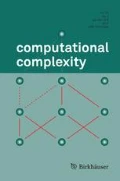Abstract
We introduce the space function s(n) of a finitely presented semigroup \({S =\langle A \mid R \rangle}\). To define s(n) we consider pairs of words w,w′ over A of length at most n equal in S and use relations from R for the derivations \({w = w_0 \rightsquigarrow \dots \rightsquigarrow w_t = w'; s(n)}\) bounds from above the lengths of the words w i at intermediate steps, i.e., the space sufficient to implement all such transitions \({w \rightsquigarrow \dots \rightsquigarrow w'}\). One of the results obtained is the following criterion: A finitely generated semigroup S has decidable word problem of polynomial space complexity if and only if S is a subsemigroup of a finitely presented semigroup H with polynomial space function.
Similar content being viewed by others
References
Baumslag G. (1969) A non-cyclic one-relator group all of whose finite quotients are cyclic. J. Austral. Math. Soc. 10: 497–498
Birget J.-C. (1998) Time-complexity of the word problem for semigroups and the Higman embedding theorem. Int. J. Algebra Comput. 8: 235–294
Birget J.-C. (2004) Functions on groups and computational complexity. Int. J. Algebra Comput. 14: 409–429
Birget J.-C., Olshanskii A.Yu., Rips E., Sapir M.V. (2002) Isoperimetric functions of groups and computational complexity of the word problem. AMII 156(2): 467–518
Brady N., Bridson M. (2000) There is only one gap in the isoperimetric spectrum. Geometric and Functional Analysis 10: 1053–1070
N. Brady, T. Riley & H. Short (2007). The geometry of the word problem for finitely generated groups. Advanced Courses in Mathematics, CRM Barselona. Birkhauser-Verlag, Basel.
Bridson M., Riley T. (2007) Free and fragmenting filling length. JALG 307(1): 171–190
Cohen D.E., Madlener K., Otto F. (1993) Separating the intrinsic complexity and the derivational complexity of the word problem for finitely presented groups. Math. Logic Quart. 39(2): 143–157
Ding-Zhu Du & Ker-I Ko (2000). Theory of Computational Complexity. Wiley, NY.
S. Gersten (1992). Dehn functions and l1-norms of finite presentations. In Algorithms and Classification in Combinatorial Group Theory (Berkeley, CA, 1989), 195–224. MSRI 23, SV, New York.
S. Gersten (1993). Isoperimetric and isodiametric functions. In Geometric group theory I, Lecture Notes of LMS, 181, G. Niblo & M. Roller, editors, 79–96. Cambridge University Press.
Gersten S., Riley T. (2002) Filling length in finitely presentable groups. Geometricae Dedicata 92(1): 41–58
M. Gromov (1987). Hyperbolic groups. In Essays in Group Theory, S. Gersten, editor, 75–263. MSRI 8, SV.
Guba V.S., Sapir V.N. (1999) On Dehn functions of free products of groups. PAMS 127: 1885–1891
Higman G. (1961) Subgroups of finitely presented groups. Proc. Roy. Soc. 262(1311): 455–475
Kashintsev E.V. (1970) Graphs and the word problem for finitely presented semigroups (in Russian). Uchenye Zapiski Tulskogo Pedagogicheskogo Instituta 2: 290–302
Lyndon R.C., Schupp P.E. (1977) Combinatorial Group Theory. Springer, Berlin
Madlener K., Otto F. (1985) Pseudo-natural algorithms for the word problem for finitely presented monoids and groups. JSC 1: 383–418
A. Miasnikov, A. Ushakov & Dong Wook Won (2011). The word problem in the Baumslag group with a non-elementary Dehn function is polynomial time decidable. preprint, arXiv: 1102,2481.
Murskii V.L. (1967) Isomorphic embeddability of semigroups with countable sets of defining relations in finitely defined semigroups (in Russian). Matematicheskie Zametki 1: 217–224
A.Yu. Olshanskii (1997). On the subgroup distortion in finitely presented groups (in Russian). MS 188(11), 73–120.
Olshanskii A.Yu. (2012) Space functions of groups. TAMS 364(9): 4937–4985
A.N. Platonov (2004). Isoperimetric function of the Baumslag–Gersten group (in Russian). Vestnik Moskov. Univ., Ser.1 (3), 12–17.
Remmers J.H. (1980) On the geometry of semigroup presentations. Advances in Math. 36: 283–296
J. Rotman (1984). An introduction to the theory of groups, 3d edition. Allyn and Bacon, Boston, MA.
Sapir M.V., Birget J.-C., Rips E. (2002) Isoperimetric and isodiametric functions of groups. AMII 156(2): 345–466
Trakhtenbrot B.A. (1969) On the complexity of reduction algorithms in Novikov - Boone constructions (in Russian). Algebra i Logika 8(1): 50–71
Valiev M.K. (1969) On the complexity of the identity problem for finitely defined groups (in Russian). Algebra i Logika 8(1): 5–43
Author information
Authors and Affiliations
Corresponding author
Rights and permissions
About this article
Cite this article
Olshanskii, A.Y. Space Functions and Space Complexity of the Word Problem in Semigroups. comput. complex. 22, 771–830 (2013). https://doi.org/10.1007/s00037-012-0058-0
Received:
Published:
Issue Date:
DOI: https://doi.org/10.1007/s00037-012-0058-0



